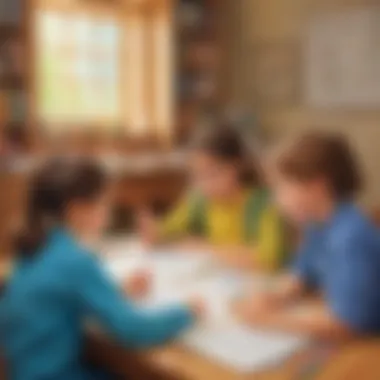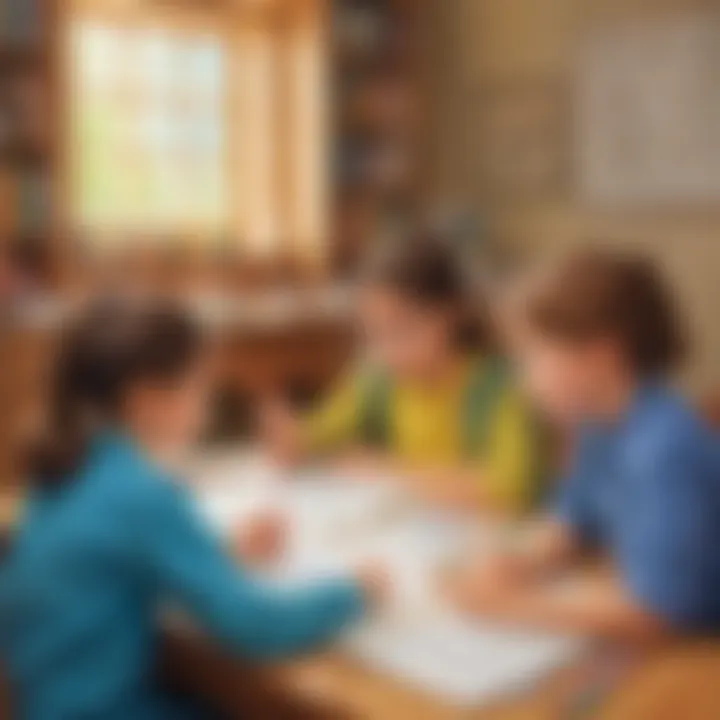Inspiring Topics for Engaging Young Minds


Intro
Selecting the right topics for elementary learners can ignite a spark of curiosity in young minds, shaping how they perceive the world around them. Those early years—ages five to twelve—are crucial. Children are not just absorbing facts; they are forming their own opinions and ideas about everything. For educators and parents, knowing how to tap into that endless fountain of creativity and critical thinking becomes ever so vital. This article aims to provide a roadmap, guiding you through the process of selecting inspirational and engaging subjects that can inspire, educate, and entertain.
Understanding how to choose these topics isn’t merely about plucking ideas from thin air. It involves a thoughtful examination of children's interests, developmental stages, and their unique learning styles. By creating a diverse portfolio of subjects, educators and parents not only enhance learning but also foster a culture of inquiry and exploration essential for lifelong learning.
The sections that follow will focus on specific creative activities designed for elementary learners, fun quizzes tailored to reinforce their understanding, and fact-based articles that present information in an engaging manner. Each part will be rich with insights, practical ideas, and a fresh perspective on everlasting themes.
Understanding the Importance of Topic Selection
Selecting the right topics for elementary learners is not just a good practice; it’s a foundation for effective education. Topics serve as the doorway to knowledge, guiding young minds through a landscape where curiosity meets understanding. When topics resonate with learners, they are more likely to engage deeply rather than merely skim the surface.
Impacts on Engagement and Learning
Engagement in the classroom is often a dance between students and the subject matter. When children encounter topics that pique their interest, it's like striking a match that lights a fire of curiosity within them. For example, introducing a lesson on dinosaurs can transform an ordinary day into an exciting adventure through time—think about the way kids buzz with energy as they discuss the T-rex. This excitement doesn't just make learning fun; it significantly boosts information retention.
Benefits of Topic Selection:
- A rich topic engages students’ emotions and makes them active participants rather than passive listeners.
- Engaged students are known to have better academic performance and show an improved attitude toward school.
- When learners dive into subjects they are passionate about, their critical thinking and problem-solving skills are enhanced.
- Topics that are relatable can bridge gaps between students' real lives and what happens in the classroom.
This affects their learning process, making it feel less like a chore and more like an exploration. By tailoring topics to align with students' interests and experiences, educators can create an environment where learning transforms into a collaborative journey.
The Role of Interests in Education
Interests play a significant role in the educational journey of elementary students. It's widely understood that children are drawn to what they love. Have you ever seen a child light up at the mention of their favorite animal? That same enthusiasm can be harnessed in education.
To foster effective learning, it is crucial to:
- Recognize Individual Interests: Each student is unique. Taking the time to understand their interests can lead to more tailored learning experiences.
- Integrate Interests into Lessons: As teachers weave thematic elements that appeal to students' hobbies, learning becomes an adventure rather than a task.
- Encourage Peer Sharing: Allowing children to share their passion with classmates fosters a community of learning where diverse interests can merge.
"Understanding what excites your learners is the key to unlocking their potential"
Identifying Relevant Subject Areas
Selecting subjects that resonate with elementary learners is crucial for nurturing their curiosity. It lays the groundwork for engagement and opens avenues for deeper exploration. When we think about what interests young learners, we can tap into their natural enthusiasm. The subjects chosen should not only align with curriculum standards but also spark imagination and critical thinking.
Core Academic Subjects
Mathematics
Mathematics serves as a backbone for problem-solving skills. Its structured nature provides students with a clear path to understand complex concepts over time. This subject is often loved for its innate logic. Whether it's counting, measuring, or simple arithmetic, students see immediate, tangible results from their efforts.
A significant aspect of Mathematics is its versatility; it fits into everyday situations. From budgeting their allowance to calculating how many candies they can buy, children find it relatable. However, some students may find Math daunting due to its abstract principles. Using real-life scenarios can make Math more approachable, helping students see its practical use in their lives.
Science
Science opens the door to understanding the world around us. It is the study of everything, from the tiniest atom to the vast universe. Children are naturally curious, and science topics can capitalize on that. Learning about weather patterns, animal habitats, or even simple chemical reactions can ignite a spark in young minds.
One of the strong points about Science is how it encourages exploration and experimentation. Yet, Science can sometimes be overly complex, leading to confusion if not approached correctly. Hands-on experiments make this complexity manageable and illustrate concepts vividly. This not only enhances retention but also fosters a lifelong love for inquiry.
Language Arts
Language Arts is the art of communication. It encompasses reading, writing, speaking, and listening. Mastering these skills is crucial for children’s overall educational journey. Language skills empower them to express thoughts and emotions clearly. This subject also promotes creativity through storytelling and poetry.
A key characteristic of Language Arts is its ability to connect diverse cultures and experiences. By exploring different genres, students not only improve their reading skills but also develop empathy. However, the focus on grammar and mechanics can sometimes hinder creative expression. Balancing these aspects is essential for fostering well-rounded communication skills.
Social Studies
Social Studies invites learners to explore their place in the world. This subject connects history, geography, and civic responsibility. Engaging with various cultures and historical events nurtures awareness and understanding of different perspectives.
The dynamic nature of Social Studies makes it a popular choice. Students can participate in discussions about current events or role-play historical figures. The downside, though, is that students may sometimes feel disconnected from the content, especially if it feels distant or irrelevant. Finding contemporary examples can help bridge this gap, making social studies resonate more with young learners.
Creative and Artistic Topics
Understanding creativity is essential in the learning process. Engaging with the arts allows students to express emotions and ideas, boosting their confidence and creativity.
Visual Arts
Visual Arts encourage children to explore their imagination. Creating works using paint, clay, or digital mediums fosters self-expression. It's a medium through which many young learners find their voice.
A distinct aspect of Visual Arts is how it integrates various skills, including fine motor control and critical thinking. This makes it an engaging choice for children. However, art-related topics might be perceived as less relevant compared to academic subjects. Integrating art into core lessons can showcase its value, reinforcing its importance in a well-rounded education.
Performing Arts
Performing Arts, including drama and dance, allows students to express themselves through movement and acting. This genre engages creativity and teamwork as children often perform in groups or ensembles. They learn to collaborate, listen to peers, and communicate effectively.
The beauty of Performing Arts is its capacity to build confidence. However, some children may feel shy or anxious about performing. Creating supportive environments can help them overcome these challenges, making Performing Arts an important part of their educational journey, as it nurtures individuality and collaboration.
Music
Music is a universal language. It transcends barriers and connects people of all backgrounds. For children, engaging with music can enhance cognitive functions while providing a creative outlet. Singing or playing instruments allows them to express emotions in a unique manner.


Its key characteristic is rhythm and pattern recognition; children learn through melodies. However, accessing formal music education can be a challenge in some areas. Incorporating music into learning—be it through songs, rhythms, or simple instruments—can mitigate barriers and make lessons more dynamic.
Physical Education and Outdoor Activities
Physical Education and outdoor activities play a vital role in children's overall development. They help in developing physical skills, social interactions, and an appreciation for nature. Including physical education not only promotes fitness but also teaches students about teamwork and perseverance through sports and games.
Incorporating Technology in Topic Selection
In today’s ever-evolving world, technology has carved a niche in shaping how we approach education, particularly in selecting topics for elementary learners. The integration of technology paves the way for learning experiences that are dynamic, interactive, and deeply engaging. This isn’t merely about using devices; it’s about harnessing tools that elevate the educational journey.
Utilizing Digital Resources
In the realm of education, digital resources have become a treasure trove for both instructors and students. With endless options available, it’s essential to identify which resources will resonate most with young minds.
Educational Apps
Educational Apps are tailored for young learners, designed to make the process of discovery enjoyable and intuitive. These apps often provide game-like environments where kids can explore subjects at their own pace. The primary draw of these apps is their capacity to make learning accessible anytime and anywhere, which is crucial for maintaining interest. One such feature is the interactive quizzes that provide immediate feedback, helping children see their growth in real-time.
However, one must remain cautious. While fun and engaging, over-reliance on apps may prevent children from developing crucial interpersonal skills since interactions are often through a screen. Balancing their use with traditional learning methods can yield the best outcomes.
Interactive Websites
Interactive Websites present a unique angle in the digital educational space. These sites often incorporate multimedia elements—videos, quizzes, and animations—that cater to various learning styles, ensuring that visual, auditory, and kinesthetic learners are all engaged. What makes these websites stand out is their potential for collaboration. Many platforms allow students to interact with their peers, fostering a sense of community, even in a digital context.
That said, one downside can be the overwhelming amount of information available online, which might confuse younger children who struggle to filter essential content from irrelevant material. Guided usage is key.
Online Courses
Online Courses offer a structured approach to learning, aiming to provide students with in-depth knowledge on specific topics. They can include video tutorials, assignments, and assessments catered to various subjects. The main attraction of these courses is their ability to promote self-directed learning. Kids can explore topics that intrigue them beyond the standard curriculum—a critical aspect for nurturing curiosity.
Nevertheless, these courses often require a level of focus and independence that may be challenging for younger learners. Integrating teacher supervision can aid in navigating these platforms effectively.
Gamification and Learning
Gamification involves applying game-design elements in non-game contexts, making the learning process more engaging. By introducing elements like point systems, levels, and badges, educators can transform traditional topics into something thrilling. This approach has been shown to not only capture student interest but significantly enhance motivation and retention.
For instance, incorporating a reward system in lesson plans can drive a classroom dynamic where students are eager to participate and expand their knowledge base. However, while gamification can yield positive results, it’s essential not to lose sight of the educational goals. Balancing excitement with educational integrity keeps students focused on the learning outcomes rather than merely on earning rewards.
"Technology, when implemented thoughtfully, can serve as a bridge connecting children’s innate curiosity with structured educational frameworks."
Incorporating technology thoughtfully into topic selection is crucial. It often requires finding the middle ground between traditional teaching methods and innovative digital resources, creating a harmonious learning environment that deeply engages young minds.
By thoughtfully leveraging technology, we can ensure that our approaches to selecting topics not only resonate with students but also foster an enduring love for learning.
Diverse Perspectives in Learning
Selecting topics that embrace diverse perspectives is crucial in education, particularly for elementary learners. It enriches their understanding of the world by introducing them to various cultures, traditions, and experiences. This approach fosters empathy and encourages critical thinking as students learn to appreciate viewpoints different from their own.
When educators incorporate diverse perspectives, they not only build a curriculum that is inclusive but also one that resonates with a broader audience. This becomes especially important in developing global citizens capable of navigating an interconnected world.
Cultural Awareness Topics
Holidays and Traditions
The exploration of holidays and traditions provides a vibrant gateway for young students to grasp the rich tapestry of cultural expressions. Each holiday encapsulates values, stories, and practices unique to the people who celebrate them. By discussing major celebrations such as Diwali, Christmas, or Lunar New Year, students can learn about the significance and customs associated with these events.
A key characteristic of exploring holidays is the element of celebration. This can be a fun and engaging way for kids to connect with different cultures, making it a popular choice for educators. The unique feature lies in the storytelling aspect. Each holiday carries tales that can spark students’ imaginations and emotions.
However, educators should navigate this topic with care to avoid stereotypes or oversimplifications. Misrepresenting a culture can lead to misconceptions, which is why employing authentic voices and materials is important.
Global Geography
Examining global geography invites students to envision the world beyond their immediate surroundings. Geography is not just about maps and locations; it infuses life into the study of landscapes, climates, and people. By presenting how natural features influence cultures and lifestyles, students can appreciate the interconnectedness of existence.
The key characteristic here is the dynamic relationship between people and their environment. This topic is beneficial as it encourages spatial awareness and cultivates curiosity. Young learners, through the lens of geography, gain insights into different lifestyles and can draw parallels to their own.
One disadvantage might be the overwhelming amount of information, as geography can span vast topics. It’s essential to keep lessons focused and relevant to maintain engagement.
Historical Figures
Diving into historical figures allows young learners to explore the lives of influential individuals who shaped societies. This topic not only highlights achievements but also delves into the complexities of their choices and actions.
A defining element of studying historical figures is the biographical narrative. This brings history to life and helps students understand the context of past events. By looking at the stories of people like Rosa Parks, Albert Einstein, or Nelson Mandela, kids can identify qualities that resonate with them, fostering connection and admiration.
However, the challenge lies in balancing the portrayal of these figures. It’s crucial to provide a nuanced picture that considers both accomplishments and flaws. This comprehensive approach can provoke deeper discussions about ethics and morality.
Exploring Scientific Diversity
Environmental Science
Engaging with environmental science is vital in nurturing ecological literacy among young learners. By understanding the relationship between humans and nature, students can become more responsible stewards of the environment. This topic contributes to their overall education by driving home the importance of sustainability and conservation.
A key aspect of environmental science is its relevancy to current global issues. Kids today are more aware of environmental problems, so discussing this topic can resonate deeply with them. The unique feature is the hands-on experience students can gain through activities like gardening or recycling projects.


However, the disadvantage is the potential for anxiety. When discussing dire environmental concerns like climate change, it can be overwhelming. Teachers should ensure to balance these discussions with messages of hope and empowerment.
Marine Biology
The world beneath the waves captivates young imaginations and gives way to discussions about marine biology. It covers the study of ocean life and ecosystems, instilling awe and respect for aquatic creatures. This topic contributes significantly to fostering a love of science through fascinating specimens, such as sharks and coral reefs.
Marine biology’s key characteristic is its diversity of life in the ocean. Through this exploration, students learn about adaptability and the delicate balance of ecosystem health. The unique feature lies in the potential for experiential learning, possibly through field trips to aquariums or beaches.
One downside might be the limited accessibility to field experiences for some schools. Creativity in resource management and virtual experiences can help bridge this gap.
Astronomy
Astronomy opens up a universe of curiosity about stars, planets, and the vastness of space. It ignites imaginations and inspires dreams of exploration. Highlighting topics such as the solar system or significant discoveries, like those by Galileo or Voyager, fosters a sense of wonder about the cosmos.
A key characteristic here is the cross-disciplinary connections astronomy can create with math and science. It’s beneficial since it encourages students to think critically and apply creative problem-solving skills. The unique feature of astronomy lies in its ability to make students ponder life's bigger questions.
On the flip side, some young learners might find abstract concepts tricky. Teachers may need to simplify explanations and utilize engaging visuals and activities to anchor understanding.
Hands-On Learning Experiences
Hands-on learning experiences form the cornerstone of engaging educational practices for elementary learners. These activities not only allow children to participate actively in their learning journey but also bridge the gap between theoretical knowledge and practical application. By immersing students in tangible experiences, educators help cultivate an environment where curiosity thrives and understanding deepens. Moreover, these experiences often cater to various learning styles, ensuring that every child has the opportunity to engage in ways that resonate with them best.
Benefits of Hands-On Learning
- Engagement: When children physically engage in their learning, their attention is captured more effectively. This type of participation sparks their interest and encourages a willingness to explore new concepts.
- Critical Thinking: Hands-on activities encourage learners to solve problems and think critically. Instead of passively receiving information, they actively manipulate materials, which requires higher-order thinking skills.
- Collaboration: Many hands-on experiences involve group work, fostering team-building skills and promoting peer interaction. Children learn different perspectives while collaborating on projects, preparing them for future teamwork in diverse settings.
- Retention: Studies show that students tend to retain information better when they have the chance to practice concepts rather than just hear about them. This is because hands-on activities create memorable connections that stick in students' minds.
Considerations
When implementing hands-on learning, several factors should be kept in mind. Safety is paramount; ensure materials are age-appropriate and non-toxic. Time management also plays a critical role, as these activities can extend beyond planned time frames. Additionally, instructors should be prepared to provide guidance while allowing students the freedom to explore independently.
Experiential Learning Activities
Experiential learning activities allow students to learn by doing. This approach is grounded in the view that practical experiences can lead to deeper understanding when tied back to the curriculum. Think of science experiments where children can mix substances to see reactions or art projects that let them unleash their creativity. These kinds of activities bring textbook concepts to life, creating memorable experiences that engage both the mind and body.
Consider examples of experiential learning activities:
- Science Experiments: Creating simple weather instruments like barometers or wind vanes can teach children about weather patterns in a practical manner.
- Art Projects: Encourage learners to create art using recycled materials, integrating discussions about sustainability and the environment into the process.
- Cooking Projects: Involving students in cooking can introduce them to measurements and fractions while exploring nutrition.
Field Trips and Community Engagement
Field trips and community engagement activities enhance the educational experience by taking learning outside the classroom. By visiting local museums, parks, or historical sites, children can witness firsthand the subjects they learn about in school. This exposure not only reinforces their curriculum but also sparks new interests that might not be conceivable within classroom walls.
"Field trips energize and motivate students, providing them with contexts for the information they learn in class. They go beyond the textbooks to see real-world applications."
Key Advantages of Field Trips
- Real-World Learning: Children can connect academic content with real-life experiences, making the learning process more relatable and exciting.
- Cultural Engagement: Trips to cultural events or venues expose learners to diverse perspectives and practices, fostering inclusivity and empathy.
- Community Connections: Engaging with local experts or participating in community service projects strengthens ties to the local environment and promotes civic responsibility.
When orchestrating field trips or community-based learning experiences, open dialogues with students about their preferences and interests can help tailor these activities for maximum impact.
In summary, incorporating hands-on learning experiences, including experiential activities and field trips, enriches the educational journey for elementary learners, creating opportunities for curiosity, exploration, and growth.
Feedback Mechanisms in Topic Selection
Selecting the right topics for young learners involves much more than simply picking subjects off a list. Feedback mechanisms play a pivotal role in shaping how effectively these topics resonate with students. Understanding what engages children best requires an open dialogue among educators, parents, and, most importantly, the students themselves. This approach helps in creating a tailored educational experience that sparks curiosity and promotes deeper learning.
Gathering responses from students offers unique insights into their interests, preferences, and learning styles. When children are allowed to voice their opinions, it not only boosts their confidence but also encourages an active involvement in their education. Additionally, involving parents and educators in this feedback loop enriches the perspective on what may work best for different types of learners, ensuring that selected topics are both relevant and impactful. Here are some key benefits of implementing effective feedback mechanisms:
- Enhanced Engagement: Understanding student interests often leads to higher motivation levels, creating a more dynamic learning environment.
- Customization: Feedback allows educators to tailor lessons that cater to specific needs, making learning more personalized and effective.
- Responsiveness: Topics can be adjusted based on what resonates with learners, ensuring that the curriculum stays fresh and relevant.
Involving the voices of students can revolutionize the way subjects are perceived in an educational setting.
By engaging with feedback mechanisms thoughtfully, educators can create a more vibrant and responsive educational atmosphere for elementary students.
Gathering Input from Students
To truly capture what excites young minds, educators must actively seek the input of the students. This can be done through various methods, such as surveys, suggestion boxes, or class discussions. It's essential to create a comfortable space where children feel safe expressing their opinions. Here are a few practical ways to gather input:
- Surveys and Questionnaires: Simple forms can be circulated to help gauge student interests with quantitative results.
- Brainstorming Sessions: Regularly scheduled discussions allow students to freely share ideas, nurturing their creative thinking.
- Interactive Voting: Utilizing a digital platform or simple show of hands for selecting topics can make the process engaging and fun.
The key is not just to ask questions but also to actively listen and respond to what students share. When students see that their input is valued, their engagement will likely soar, leading to better learning outcomes.
Involving Parents and Educators
While student feedback is crucial, the insights of parents and educators cannot be overlooked. They provide a broader context regarding the child’s learning environment and emotional well-being. Involving these stakeholders can foster a collaborative approach to selecting topics. Here are some strategies:
- Parent Surveys: Gather insights from parents to understand their perspectives on what subjects they believe would engage their children.
- Workshops for Educators: Holding sessions where teachers can discuss and analyze student feedback, thus leading to a collective understanding of what works.
- Communication Platforms: Foster regular communication through newsletters or forums where all stakeholders can dialogue about effective topic selection.
This collaborative effort enriches the process, making it a community-centered approach rather than just a top-down decision. Through this teamwork, educators can better predict student engagement, ensuring that the selected topics resonate well with young learners. By integrating the feedback from students, parents, and educators, the educational experience can be tremendously enhanced, making learning not just essential but genuinely enjoyable.
Curriculum Integration
One of the main benefits of curriculum integration is that it helps students develop critical thinking skills. Rather than compartmentalizing knowledge, integrated topics allow for discussions that span various domains. This can lead to deeper understanding and retention of material.


For instance, a science topic such as ecosystems can be tied to language arts through storytelling or writing projects. Similarly, lessons on the history of exploration can incorporate math through mapping and geography. This method enriches the content, making it multi-dimensional and more relatable to the students' everyday lives.
Considerations regarding curriculum integration include ensuring that the topics chosen align with educational standards while still being engaging. It requires careful planning and collaboration among educators to develop cohesive lessons that can smoothly transition between subjects.
"Education is not the filling of a pail, but the lighting of a fire." - W.B. Yeats
In embracing curriculum integration, educators open doors to creativity and inspiration. It cultivates an environment where students feel empowered to explore and make meaningful connections, ultimately nurturing a lifelong passion for learning.
Connecting Topics Across Subjects
Connecting topics across subjects is not just a strategy; it’s a philosophy that enhances the educational experience of elementary learners. When different subjects are woven together, students begin to see how knowledge from one area can illuminate and inform another. This interconnectedness deepens their understanding and ignites curiosity.
For example, a project on weather patterns can naturally link science to art. Students could create visual representations of different weather scenarios or design their own weather stations. Likewise, a history lesson on Native American cultures might include art by recreating traditional crafts or storytelling that reflects their values and perspectives. This approach fosters collaborative and engaging learning experiences.
Key elements to successful integration include:
- Clear objectives: Define what students should learn from both subjects clearly.
- Creative collaboration: Encourage teamwork among teachers to design lessons together.
- Student engagement: Incorporate methods that actively involve students in their learning process.
By fostering these connections, students can grasp more complex concepts and retain information longer.
Thematic Units for Deeper Understanding
Thematic units resonate well with elementary learners, giving them a framework through which they can delve deeply into topics. A thematic unit centers around a specific theme or topic and ties various subject areas together seamlessly.
For instance, a unit themed around "Under the Sea" can integrate science (ocean ecosystems), language arts (reading about marine life), and art (creating ocean-themed crafts). This method not only supports diverse learning styles but also encourages students to explore a topic from multiple angles, leading to greater mastery and understanding.
Benefits of thematic units include:
- Cohesion: Provides a structured approach to learning that reinforces a central idea across different subjects.
- Interest and engagement: Captivates the learners' attention by allowing them to explore an interest in depth.
- Critical thinking: Encourages students to ask questions and seek answers across various disciplines.
As children engage in thematic units, they build a framework of knowledge that not only empowers them academically but also nurtures their creativity and problem-solving skills. Such comprehensive exploration transforms their learning experience into a vibrant tapestry of understanding.
Evaluating Topic Effectiveness
Evaluating the effectiveness of selected topics plays a critical role in the learning journey of elementary school kids. This process is not merely about assessing whether a topic was interesting; it's about understanding how well it resonated with learners and facilitated genuine engagement. When educators take the time to analyze what works and what doesn’t, they ensure that the learning experience is enriching and valuable.
Assessing Student Engagement
Engagement is the heartbeat of effective learning. If students are not involved, understanding suffers. To gauge engagement, one can observe student reactions during lessons—listening to their discussions, watching their participation, or even noting their enthusiasm during activities. Educators might consider using surveys or informal discussions with students to assess how connected they feel to the topic.
For instance, a teacher who introduced a unit on space might ask students to share their thoughts after a lesson on the solar system. Questions to consider:
- Were the students excited to share their ideas?
- Did they ask questions that showed curiosity or interest?
- Were they actively participating in group work or discussions?
Using tools like classroom polls can also be effective. Feedback can help educators identify which topics captured students’ imaginations and which fell flat.
Measuring Learning Outcomes
Once engagement is assessed, it’s vital to measure learning outcomes. This involves looking at what students learned from the topic. Did they grasp the essential concepts? Were they able to apply their knowledge in practical situations? Standard assessments, such as quizzes, projects, or presentations, can offer insight into how well students internalized the material.
Consider using the following methods to evaluate learning:
- Pre-and Post-Assessments: Administer a simple quiz before starting a new topic and then another after completion to measure knowledge gain.
- Projects: Assign projects where students showcase their understanding creatively. This could range from posters about historical figures to presentations on environmental science topics.
- Reflection Journals: Encouraging students to write about what they learned and how they felt about the topic can provide qualitative data on learning outcomes.
"Assessing topics is not just about finding faults but enhancing the learning process for future generations."
Ultimately, integrating these evaluation techniques allows educators to tailor their approach continually. By reviewing both engagement and outcomes, they can create a dynamic learning environment that adapts and evolves based on student needs.
Future Trends in Education Topics
In the rapidly evolving landscape of education, it's vital for educators and parents alike to grasp the significance of topic selection for young learners. Topics that reflect future trends can not only engage students but also prepare them for the challenges and opportunities that lie ahead. By focusing on forward-thinking subjects, we encourage critical skills such as adaptability, creativity, and social awareness. This article examines trends that inspire interest and relevance, including emerging fields of study and ways to adapt to digital learning settings, defining a contemporary approach to education.
Emerging Fields of Study
STEM Education Innovations
STEM education is all the rage these days, and for good reason. It emphasizes Science, Technology, Engineering, and Mathematics, and is doing wonders for getting kids excited about learning. The key characteristic here is its hands-on approach; children are not just memorizing facts but engaging in activities that demand problem-solving skills. For instance, building a simple circuit or coding a game does wonders for their analytical skills.
A unique feature of STEM innovations is their integration into everyday life—think about how many gadgets we interact with daily. This familiar context can make complex concepts more accessible. The major advantage here is that it fosters an early interest in critical careers. However, there are potential downsides. Not every child may vibe with science or math, risking feelings of frustration or failure. Still, with adequate support, kids often find new avenues of interest through these challenges.
Social and Emotional Learning
In today's world, the importance of Social and Emotional Learning (SEL) cannot be understated. It helps children understand and manage their emotions, empathize with others, and develop positive relationships. The standout element is its focus on emotional intelligence, an aspect often overlooked in traditional education settings.
SEL can be woven into discussions on current events, encouraging children to express their thoughts and feelings about issues affecting them. This approach can contribute to creating a well-rounded educational experience. It stands out as a beneficial choice because it not only addresses academic needs but also supports mental health and well-being. However, implementing SEL requires training for educators, which may be a challenge in some schools.
Environmental Education
With pressing concerns about climate change, Environmental Education is essential for molding responsible future citizens. A central part of this topic lies in teaching children about sustainability, conservation, and the interconnectedness of life. Learning about the environment can spark curiosity; students can observe local ecosystems or participate in community clean-ups.
One unique feature of this subject is its potential for real-world application. Whether it's growing a garden or conducting an environmental audit, the hands-on nature engages students directly in their community. The advantages are clear: it cultivates informed citizens who take action. Nevertheless, challenges remain in conveying these topics in engaging ways. If not presented well, they can seem abstract or overwhelming to young minds.
Adapting to Digital Learning Environments
As education makes the leap into more digital spaces, it’s essential to mold topics that adapt seamlessly into these formats. Digital learning environments allow for interactive experiences where children can explore ideas in a virtual setting. For example, utilizing platforms like educational games or simulation apps presents concepts in engaging ways, making learning fun and memorable.
"Engagement is the name of the game when selecting topics for today’s students. Technology enhances accessibility and allows exploration beyond classroom walls."
In summary, as educators and parents consider topics for elementary learners, looking toward future trends equips children with the skills to thrive. By focusing on areas like STEM, social and emotional learning, and environmental care, insights are being offered that go beyond academic success. This approach sets the stage for a generation of thinkers who are prepared for what's next.







